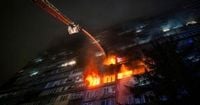As the sun rose over Kyiv on October 11, 2025, the city buzzed with a cautious sense of relief. Power had been restored to over 800,000 residents, just a day after a barrage of Russian drone and missile strikes plunged much of Ukraine into darkness and left at least 20 people wounded in the capital. The attacks, described by Ukrainian Prime Minister Yulia Svyrydenko as "one of the largest concentrated strikes" against the nation’s energy infrastructure, marked yet another chapter in Russia’s relentless campaign to cripple Ukraine’s power grid as winter looms.
Ukraine’s largest private energy company, DTEK, announced on Saturday that "the main work to restore the power supply" had been completed. Still, the scars of the onslaught lingered: some localized outages persisted, and the city’s battered neighborhoods bore fresh wounds from the barrage that struck residential buildings and vital infrastructure.
According to BBC and multiple European outlets, the Russian Defense Ministry claimed responsibility for the strikes, stating they had targeted energy facilities supplying Ukraine’s military. The Ministry boasted of using Kinzhal hypersonic missiles and strike drones in the assault, though it provided scant details about the specific targets or the broader strategy behind the attack. For Kyiv’s residents, the technicalities mattered little compared to the sudden loss of light, heat, and security.
Friday’s attack was not an isolated incident. Ukraine’s air force reported that, overnight, its air defenses had intercepted or jammed 54 of 78 Russian drones launched against the country. Meanwhile, Russia’s own defense ministry claimed to have shot down 42 Ukrainian drones over Russian territory, illustrating the ongoing tit-for-tat escalation in the skies above Eastern Europe.
Elsewhere in Ukraine, the violence was even more deadly. In Kostiantynivka, a city in the embattled Donetsk region, at least two people were killed and five wounded in airstrikes on Saturday, according to regional Governor Vadim Filashkin. The human toll of the conflict continues to mount, even as world attention shifts elsewhere.
President Volodymyr Zelenskyy, in a series of public statements and a nightly address, sought to rally both his countrymen and Ukraine’s international partners. On Saturday, he described a "very positive and productive" phone call with U.S. President Donald Trump. According to Zelenskyy, the two leaders discussed the latest Russian attacks on Ukraine’s energy system and explored opportunities to strengthen Ukraine’s air defense. "There needs to be readiness on the Russian side to engage in real diplomacy — this can be achieved through strength," Zelenskyy wrote on X, the platform formerly known as Twitter.
Zelenskyy’s appeals for aid come at a critical juncture. Ukraine’s energy sector has been a key battleground since Russia’s full-scale invasion began more than three years ago. Each fall, as temperatures start to drop, Russian forces have intensified their efforts to knock out Ukraine’s power grid, hoping to erode public morale and force concessions at the negotiating table. Winter in Ukraine is notoriously harsh, with freezing temperatures stretching from late October through March and January and February bringing the coldest days. The timing of the latest strikes is no accident.
In his Friday night address, Zelenskyy warned that Russia was taking advantage of the world being "almost entirely focused on the prospect of establishing peace in the Middle East," a reference to the shifting priorities of global diplomacy. He called for urgent action to strengthen Ukraine’s air defenses and for tighter sanctions on Russia. "Russian assets must be fully used to strengthen our defense and ensure recovery," he declared in his video address.
The question of how to pay for Ukraine’s defense and reconstruction is becoming ever more pressing. Ukraine’s budget and military needs for 2026 and 2027 are estimated to total around $153 billion, a staggering sum for a nation already battered by years of war. Since the conflict erupted in February 2022, the European Union has poured in about $202 billion in aid, but the scale of the challenge continues to grow.
In a significant development on Friday, British Prime Minister Keir Starmer, French President Emmanuel Macron, and German Chancellor Friedrich Merz issued a joint statement signaling their readiness to move toward the coordinated use of frozen Russian sovereign assets to support Ukraine’s armed forces. "We are ready to move toward using, in a coordinated way, the value of the immobilized Russian sovereign assets to support Ukraine’s armed forces and thus bring Russia to the negotiation table," the statement read, as reported by Reuters. The leaders emphasized that this would be done "in close cooperation with the United States."
The biggest pot of ready funds sits in Belgium—around $225 billion as of June 2025. Additional sums are held in Japan (about $50 billion), with smaller amounts in the United States, United Kingdom, and Canada. The move to leverage these assets marks a shift in the West’s approach, signaling a willingness to use Russia’s own wealth to help Ukraine resist and recover from the devastation wrought by the invasion.
For many Ukrainians, the international support is both a lifeline and a source of anxiety. The prospect of winter without reliable power is daunting, and memories of last year’s blackouts are still fresh. Russia’s strategy of targeting energy infrastructure is designed to sow fear and hardship, and each attack tests the resilience of Ukraine’s people and institutions.
Yet, there is also a sense of determination. DTEK’s rapid restoration of power to the vast majority of Kyiv’s residents stands as a testament to the grit and ingenuity of Ukrainian engineers and emergency crews. Their efforts, often carried out under the threat of renewed attacks, have become a symbol of national resolve.
Meanwhile, the diplomatic and financial maneuvers unfolding in European capitals and Washington may prove just as critical as the battles on the ground. The coordinated effort to unlock frozen Russian assets could provide Ukraine with a much-needed financial cushion, while also sending a message to Moscow that the West’s commitment to Ukraine remains firm—even as global attention shifts elsewhere.
As Kyiv’s lights flicker back on and families gather around newly powered heaters, the struggle to defend Ukraine’s energy grid and sovereignty continues. The coming winter promises new challenges, but also opportunities for unity and resolve—both at home and among Ukraine’s allies abroad.




